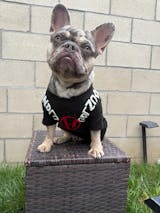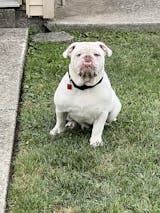What is Cherry Eye?
Did you know that dogs have three eyelids instead of two? Their third eyelid sits under the eye's inner corner. If that third eyelid becomes prolapsed, it becomes swollen and a smooth, round, red or pink mass that looks like a cherry pit appears in the corner of the eye. That prolapsed eyelid is commonly called "cherry eye." The medical term for the condition is "eyelid pyopexy." In this article, we will discuss the causes, symptoms, and what can be done if your dog develops cherry eye.

What Causes Cherry Eye?
Cherry eye is most often seen in young dogs that are less than one year old. Brachycephalic breeds such as French Bulldogs, English Bulldogs, Boxers, Cavalier King Charles Spaniels, Shih Tzus, Boston Terriers, Mastiffs, and Pugs are more prone to the condition. The condition arises when the small ligament that holds the third eyelid gland in place either stretches or breaks. The reason that occurs is unknown, but it is thought to be a congenital defect (present at birth) or due to an injury to the third eyelid. The fact that it is seen more often in certain breeds, suggests that there may also be a genetic component.
What are the Symptoms of Cherry Eye?
The most obvious symptom of cherry eye is a bulging or protruding gland on the inner corner of the dog's eye (the side closest to the nose). This gland is normally not visible, but when it prolapses, it becomes quite noticeable. In some cases, both glands may prolapse. Other symptoms include:
- Discharge from the affected eye
- Tearing
- Squinting or rubbing at the eye
What Do I Do if I Think My Dog Has Cherry Eye?
If you believe your dog has cherry eye, it is important to take them to a veterinarian. There is no way to prevent this condition from occurring and it generally requires surgery to correct. If left untreated, cherry eye can lead to more serious problems like corneal ulcers and glaucoma.
Cherry eye is diagnosed by examining your dog's eyes. The clinical appearance of cherry eye, particularly in puppies, aids in the diagnosis. Your veterinarian may also utilize a variety of diagnostic tests, such as fluorescein staining, to examine the general health of your dog's eyes.
Once the diagnosis has been made, your veterinarian will discuss a treatment plan which will most likely involve surgery.
Your veterinarian will give you specific instructions on how to care for your dog after surgery. This will usually involve applying ointment to the eye several times a day and keeping the area clean and free of debris. Squishface Wrinkle Wipes make it easy to keep the area clean.
Our alcohol-free formula is gentle and will not sting so that you can keep the area clean and protected. The Squishface Wrinkle Wipe formula was created specifically for dogs with sensitive skin, and intentionally leaves out common and unnecessary irritants such as essential oils, aloe, fragrance, and lanolin. Our wipes also have phytosphingosine in them. Phytosphingosine is a pro-ceramide with anti-inflammatory and microbe repelling properties.
The Bottom Line
Cherry eye is a condition that commonly affects young, brachycephalic breeds and requires surgery to correct. If you think your dog may have cherry eye, take them to the veterinarian as soon as possible. Once diagnosed, your veterinarian will discuss treatment options which will most likely involve surgery.
After surgery, it is important to keep the area clean and free of debris. Squishface Wrinkle Wipes can help with that.
For more tips and tricks about caring for your wrinkly dog, visit our blog weekly.










